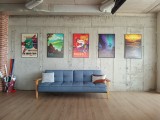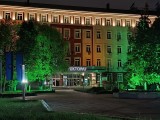Motorola Edge 40 review

A 50MP primary and a 13MP ultrawide, 32MP sensor for selfies
The Edge 40 has a simple dual camera setup on the back - a 50MP wide primary unit and a 13MP ultrawide one, with no telephoto and no 'depth' or 'macro' nonsense. On the front, there's a 32MP selfie camera. In a way, that rounds up the Edge 30 Fusion's camera system, but it's not quite the same.

The primary camera does use the same OmniVision OV50A sensor, also featured on the 40 Pro and 30 Pro. It has a 1/1.55" optical format, so it's fairly large as midrange cameras go. Individual pixel size is 1.0µm, and since it's a 4-cell design (OV's naming for what Sony calls Quad Bayer and Samsung - Tetrapixel), you're effectively getting 4-to-1 binned 12.5MP images with 2.0µm pixels - that last number is stamped on the back of the phone next to the cameras.

The sensor has 2x2 on-chip lenses and all-pixel phase detection autofocus - you can have a look at Sony's explanation for the same technologyhere.
Where the Edge 40's main camera stands out from the units on its brethren, is the lens - while all the others have an f/1.8 aperture, this one is noticeably brighter, at f/1.4. That should give you better low-light performance and a shallower depth of field for some extra subject separation. It still has OIS.
The ultrawide camera does come from the 30 Fusion and in that sense it's not as good as the one used on the 40 Pro or even last year's vanilla 30 but as you will see, it's not too shabby either. It is based on a 13MP SK Hynix HI1336 sensor with 1.12µm individual pixels and a 1/3" optical format. The f/2.2 aperture lens does feature autofocus, so it can double as a close-up camera.
Over on the front, the Edge 40 uses a different 32MP sensor than the one we encountered on the Edge 30 Fusion - it's the OmniVision OV32B here, as opposed to the Samsung S5KGD2. This one is smaller (1/3" vs. 1/2.8") and has a 0.7µm pixel size (4-cell design, too, like the main camera on the back). Another difference from the Fusion's selfie camera is the lack of autofocus here. Bummer.

The camera app on the Edge 40 is developed in-house, in contrast to the otherwise stock-looking approach to software.
The basics are as usual - the camera modes are arranged in a customizable carousel formation, with the 'More' tab at the rightmost end of the carousel holding the more seldom-used shooting modes.
Pro mode gives you full control over the camera's settings like white balance, ISO, focus, shutter speed, and exposure compensation, and it works on all cameras - both rear ones and the selfie camera (minus the manual focusing). A tiny live histogram is provided, but there's no focus peaking or zebras.
Additional settings for each camera mode can be found by swiping down in the viewfinder. There's a tiny bar at the far end to indicate that, but if you miss it, you may be left wondering where some controls are, like the self-timer settings in Photo mode and frame rate in Video mode.
The gear icon for the general settings menu houses even more settings, though there isn't a straightforward separation of what you're going to find where. For example, the full-res mode for selfies is found in the settings menu, while full-res capture for the rear cameras is accessed from the 'Ultra-Res' mode on the carousel. A lot of the app's peculiarities are long-standing Moto things, so you may be right at home if you're a recurring user, but that doesn't necessarily make them intuitive.
Daylight image quality
The daylight photos from the Edge 40 main camera are good, but not without their flaws. Coming in at 12.5MP by default, the images are free of noise and capture plenty of detail, though random textures can look artificial (which is mostly the norm, in fact).
We got to test the phone during an unusually dreary period in May, and finding a sunny scene was a challenge, but the overcast weather was a good test for the camera's dynamic range, and we'd say it passed with flying colors. Speaking of colors, we like the Edge 40's take on reality, with only the overly enthusiastic rendition of greenery in some scenes rubbing us the wrong way.
It's worth noting that capturing close-up subjects with any amount of depth in them can be tricky with the very wide aperture on the Edge 40's main camera. On the other hand, that means that you get to isolate subjects with ease, throwing the background out of focus and making it just a blur of color.
















Daylight samples, main camera (1x), 12.5MP
We found no advantage in resolved detail when shooting in the Ultra-Res 50MP mode - things are just bigger and blockier.








Daylight samples, main camera (1x), 50MP
With that in mind, it's no surprise that shots captured at 2x zoom don't stand up too well to pixel-level scrutiny. Then again, the Moto doesn't insist that you shoot at 2x in the first place - there's no direct shortcut to that zoom level, and we only pinch-zoomed just to give it a try. So overall, if you manage your expectations, you may just end up satisfied with the occasional zoom shot.








Daylight samples, main camera (2x zoom)
The ultrawide's results aren't going to be winning any image quality contests, but they aren't bad either. The clouds did result in darker exposures than we'd like, but the phone still managed to capture good dynamic range under these difficult conditions. Colors are mostly likeable, though on occasion, they were missing some pop (mostly indoors), and there's also that botched white balance on the phone mural shot. Detail is solid for the class.












Daylight samples, ultrawide camera (0.5x), 12.5MP
Closeups
The macro mode on the Edge 40 is accessed by a button on the zoom selector in Photo mode. It switches to a cropped-in and upscaled view from the ultrawide camera, which matches the main camera's field of view. The results are pretty decent overall, especially in the context of smartphone 'macro' cameras - detail is good, colors are nice and vivid.
Low-light image quality
The 'Auto Night Vision' toggle in the Edge 40's viewfinder comes pre-enabled; thus, the phone will automatically apply night mode processing. It does it both on the main camera (but not when zoomed in) and the ultrawide, and the differences between the Auto results and the dedicated Night mode ones are essentially nonexistent.
Main camera
Shooting on the main camera, you'd be getting excellent dynamic range with well-developed shadows and preserved highlights. We experienced no issues with white balance with street lighting, and we also got great color saturation. Detail is very good, the noise is contained very well, and the watercoloring effect characteristic of Night modes is barely there.








Low-light samples, main camera (1x), Auto Night Vision
Here is how the same scenes are rendered in the dedicated Night Vision mode.








Low-light samples, main camera (1x), Night Vision
Where you will see differences is in the images captured with Auto Night Vision turned off in Photo mode. It's not a dramatic change in this case, but there is a subtle improvement in the way detail is rendered in well-lit areas - it's finer and more natural. Then again, darker areas can get mushy. Overall, we'd be happier keeping the Moto in full Auto.








Low-light samples, main camera (1x), Auto Night Vision OFF
It's not quite so when zooming in, where the Auto doesn't engage the Night Vision processing, and you'd get a pretty harsh rendition of the tonal extremes.



Low-light samples, telephoto camera (2x), Auto Night Vision
Night Vision fixes that, albeit at the expense of a pretty overprocessed look to fine detail.



Low-light samples, telephoto camera (2x), Night Vision



Low-light samples, telephoto camera (2x), Auto Night Vision OFF
Ultrawide camera
Whether in Auto Night Vision or standalone Night Vision mode, the Edge 40's results from the ultrawide camera look the same. There's some excessive brightening of the shadows going on - or, rather, attempts at brightening the shadows - which the hardware doesn't quite have the potential to pull off, so the night sky and other very dark areas are rendered in a navy blue.
Other than that, white balance is generally accurate, and colors do maintain a good level of saturation. Detail is okay - it wasn't great during the day, but in the context of midrange ultrawides at night, it's pretty decent.







Low-light samples, ultrawide camera (0.5x), Auto Night Vision
Here are the same scenes as shot in Night Vision mode.







Low-light samples, ultrawide camera (0.5x), Night Vision
For completeness' sake, here's how the same scenes would look with the Auto Night Vision turned off. These are darker and noisier, but at least there are none of those navy shadows.







Low-light samples, ultrawide camera (0.5x), Auto Night Vision OFF
Once you're done with the real-world samples, head over to our Photo Compare tool to see how the Motorola Edge 40 stacks up against the competition.



Motorola Edge 40 against the Pixel 7 and the Nothing Phone (1) in our Photo compare tool
Portrait mode
Motorola has taken a similar approach to Portrait mode on the Edge 40 that we saw on the 30 Ultra and the 40 Pro. You get three focal lengths - Standard (50mm), Wide (35mm), and Full view (24mm), all of them sourced from the main camera (duh). The absence of a telephoto camera here means there's no 85mm mode like the one you'd find on the other two phones, and those were, in turn, missing the 24mm mode.
In the 50mm mode detail is pretty bad on a pixel level, thanks to what has to be a combination of upscaling, sharpening, and HDR. The 35mm mode we'd label 'good' in terms of detail, possibly even 'very good', and the native 24mm mode is great when viewed from up close.
The blur level is different for each mode and is very well judged to mimic what you'd expect to get with a bright lens at that focal length. Subject detection was generally excellent, and even the usually troublesome wooden wall paneling proved a non-issue.
The super bright lens of the Edge 40's main camera means you don't necessarily need to resort to using Portrait mode to throw the background out of focus. While closer backgrounds can't quite 'disappear', more distant backdrops will be blurry enough not to distract from your subject.




Natural background defocusing - Portrait mode OFF, 24mm
Selfies
The Edge 40 captures 8MP selfies by default, though you can access an option for native 32MP resolution shooting from the camera app's settings even if we can't imagine why you'd want to.
The default images are excellent. Detail is great, skin tones are lifelike, and the wide dynamic range guarantees top quality in difficult conditions too.
Video recording
The Edge 40 supports video recording up to 4K30 with both its main camera and its ultrawide on the back, as well as the selfie camera. Only the main rear camera can record at 60fps, and in that case resolution is up to 1080p - the selfie camera and the ultrawide can't capture 60fps at all.
The default codec is h.264, though you can flip a toggle and switch to h.265. 4K30 videos get a 50Mbps bit rate (when using h.264), and audio is recorded in stereo at 256kbps. Stabilization is available in all modes on all cameras.
The main camera of the Edge 40 captures very good 4K30 videos. Sharpness and detail are great, dynamic range is excellent, and colors are mostly likable, save for the needlessly lush greens.
The ultrawide's rendition of grass and tree crowns is more toned down and arguably better looking. Dynamic range is nicely wide again, and detail is best described as okay - it's not the sharpest clip, but it's good enough. Not quite so is the ultrawide camera's inability to maintain a steady 30fps frame rate - we were getting a little over 24fps for our tripod-mounted footage, though handheld videos did hover around the 30fps mark.
Low light video recording on the Edge 40's main camera is quite good for the class. It's sharp and detailed, and noise reduction is handled well. Dynamic range is respectable, and there's minimal haloing around light sources. Colors don't suffer from desaturation, either.
The ultrawide's low-light performance is not up to that same standard, however. Dynamic range is limited, shadows are underdeveloped, and there's a significant amount of noise that's pretty in-your-face.
Stabilization is okay on the Edge 40 with some caveats. Whether it's the main camera or the ultrawide, walking shake tends to throw its focus off and we're seeing some hunting, and that can occasionally happen when panning too. Pans themselves are otherwise smooth though, with no abrupt transitions. Also, if you're just pointing the camera in one direction, you'd get mostly steady footage, but it's not quite entirely shake-free.
Here's a glimpse of how the Motorola Edge 40 compares to rivals in our Video compare tool. Head over there for the complete picture.



Motorola Edge 40 against the Pixel 7 and the Nothing Phone (1) in our Video compare tool
Reader comments
- Nikojas
- 13 Jul 2024
- GXs
Has it got android 14 in Europe by now?
- Daniel
- 17 Jun 2024
- g8V
This one or the edge 50 pro? Greetings from Sofia ;)
- Anonymous
- 09 Jun 2024
- XrR
Yes pinch too zoom works in video recording mode



























